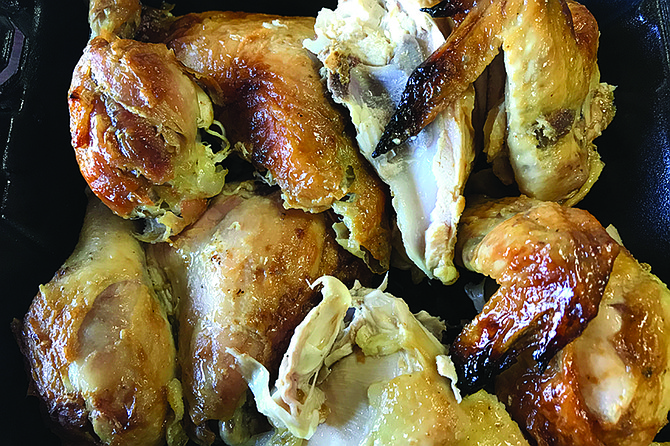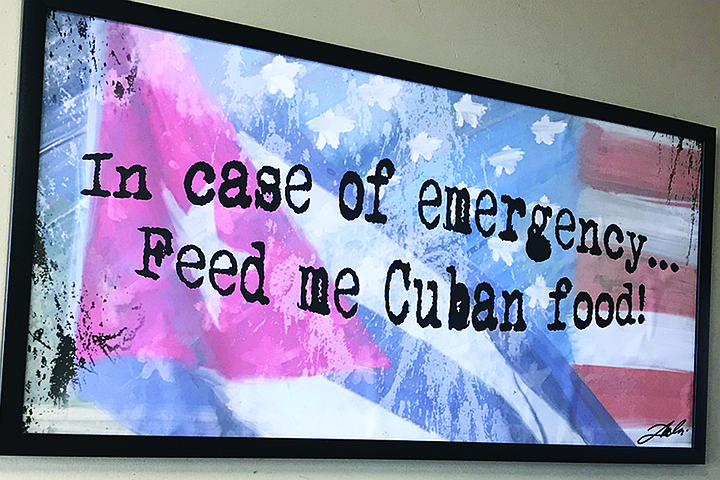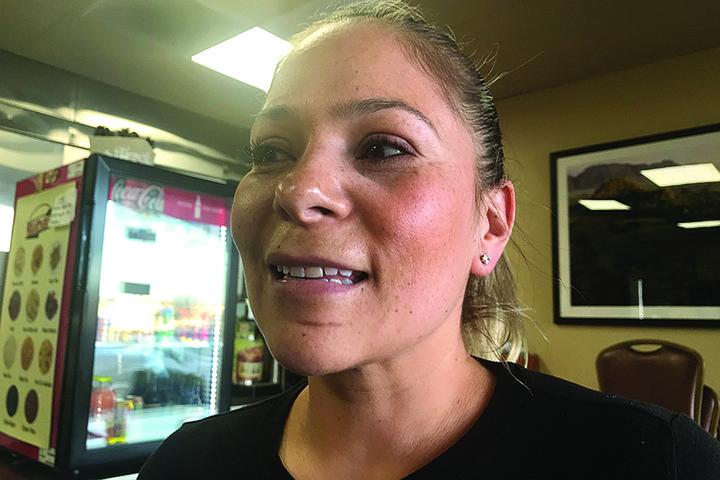 Facebook
Facebook
 X
X
 Instagram
Instagram
 TikTok
TikTok
 Youtube
Youtube

“I was a professor,” says Rafael. “A licenciado. I taught history, specializing in Persia and Greece. And in 2015, I was named best teacher in the nation.”
That nation was Cuba. Yet now he’s a chef, here at Los Pollos Bakery.

Rafael has come out from the kitchen of what I thought was a chicken joint. Los Pollos, right? My friend Henry loves the chicken, but discovered they had a whole Cuban thing going on as well. “And dude,” he told me, “Cuban coffee.”
Oh yes. An espresso that’s got a special kind of concentration, and sweetness. They whip the brown sugar into the first drops of coffee, the strongest ones, so you get a nice creamy foam.
But as usual, I’m late. I steam into this li’l place on Third near Palomar. And completely forget about the Cuban coffee when I see this couple, Jorge and Karla, munching away at chicken and black beans outside, right under a Cuban flag in the window. So are their two kids, Kiara (9) and Kailey (4). “Chicken’s awesome,” says Kiara. “Awesome,”repeats Kailey.

“In case of emergency, feed me Cuban food!” says this sign inside.
Henry’s been waiting. Not as mad as he might be, ‘cause he’s had that coffee.
“OK, I’m paying,” I mutter. “‘cause I was late.”
“You got it,” he says. “So let’s have chicken first, a whole chicken. I’m telling you: they’re to die for.”
Uh, Okay. “A whole chicken?” I ask.
“Yeah. Whole. Nothing really Cuban I can tell, but it has way more flavor and way less grease than the chains.”
I check. Menu says, “Whole chicken, (ulp) $19.95.” Includes two medium sides, salsa, and tortillas. We could’ve gotten a 2-piece individual meal, including a 12-ounce drink for $8.95, or a 4-piece for $11.95, but I’m kinda warming to the idea of chomping into a whole chicken.

So now, this is crazy, but I’m also detoimined to have some real Cuban nosh. I check the menu. I mean, I know enough about Cuban food to say that it’s this combo of Spanish, African, and Caribbean cooking. And that they go for squished sandwiches “a la plancha.” One’s filled with stewed beef, shredded to tenderize it, and the meat really does end up looking like the name implies: ropa vieja, “old clothes.”
But now the gal, Ingrid, passes by with a deelish-looking steaming-hot bowl. A dark lake of black beans, rice, two chunks of golden-black rotisserie chicken, some onions, and this log-shaped chunk of some vegetable, creamy-colored, straddling the top.
“Yucca,” says Ingrid, “and mojo, garlic. Also, plantains, grilled onions, rice, pork.”

Costs $8.95. It looks so sexy I almost go for that. But right below, they have these sandwiches. Famous one’s the media noche. “Midnight.” Named that because back in the pre-Castro days when Havana was like Miami’s party-town annex, they’d serve these at nightclubs around midnight. It has roast pork, ham, cheese, and pickles, inside a sweet egg-bread. The “Cubano” sandwich is the same, except with crispier regular bread, often baguette-style. They cost $7.95 each.
But last on the list is pan con lechon. Ooh. Roasted suckling pig.
That’s what I go for, not that we’re gonna have an inch of room. For starters, we have to pick two sides for the whole chicken. D’aah. Everything from ripe, sweet plantains, to arroz con gandules (rice, pigeon peas, and pork, kind of a Puerto Rican national dish), congri, which has to be one of Cuba’s national plates — basically, black beans and rice — to, hey, yuca con mojo de ajo.
Henry’s way ahead of me. “Congri and yucca?” he says. “Yucca’s like garlic potato.”
Sounds good to me.
The chicken? Lush, and we eat about half of it, along with the sides. We bathe it all in salsa (good taste, but not much heat). Congri’s rich, in that black bean, Caribbean way. Yucca’s actually deliciously like garlicky potato. All from that spiky yucca plant, “the Spanish Bayonet.” Who knew?
“Good for arthritis too,” says Henry. “Anti-inflammatory.”
I wash it down with a bottle of Malta Hatuey, from Cuba. A malt drink. Tastes like a sweet stout, but is non-alcoholic ($2.25). Oh man: now Ingrid turns up with the pan con lechon sandwich. I’m nearly bursting. But we agree to split it, and wow, Umami? This has it. It’s juicy, partly because of the mayo and garlic they put in. Plus it’s squished and toasted and hot and crunchy. Enough for a meal right there.
We even make space for what Ingrid says is a Cuban favorite from their bakery side: guava and cheese strudel ($1.15). I don’t know why guava isn’t more popular than it is.
Have to ask Rafael: why would he leave that exalted status as Cuba’s best teacher to become a cook in Chula Vista?
“I came because my sons are here. I wanted to see them have a brighter future. And I work as a cook because it would take two years for me to qualify as a teacher. I have to earn money.”
Now I’m paying the bill.
“How much?” Henry says.
“Uh, $34.15,” I say.
“Wow, seventeen each. But you know we coulda filled up on, like, four bucks each?”
“Say what?”
“Look, dude. Just right of the chicken plates, ‘Cuban specialties.’ Croquetas, 99 cents. They’re filling. Beef potato ball, $1.15. Spicy chicken potato ball, $1.15. Meat pie! $2.05. Spicy chicken empanada, $2.05. All those strudels, $1.15. Coconut, guava, mango and cheese, cheese pastry, dollar-fifteen! You made of money?”
Me, I’m muttering zen thoughts aloud, just to fight the blood pressure.
“Tell you what. We’ll try those next time, alright?” he says. “And that will be on me.”


“I was a professor,” says Rafael. “A licenciado. I taught history, specializing in Persia and Greece. And in 2015, I was named best teacher in the nation.”
That nation was Cuba. Yet now he’s a chef, here at Los Pollos Bakery.

Rafael has come out from the kitchen of what I thought was a chicken joint. Los Pollos, right? My friend Henry loves the chicken, but discovered they had a whole Cuban thing going on as well. “And dude,” he told me, “Cuban coffee.”
Oh yes. An espresso that’s got a special kind of concentration, and sweetness. They whip the brown sugar into the first drops of coffee, the strongest ones, so you get a nice creamy foam.
But as usual, I’m late. I steam into this li’l place on Third near Palomar. And completely forget about the Cuban coffee when I see this couple, Jorge and Karla, munching away at chicken and black beans outside, right under a Cuban flag in the window. So are their two kids, Kiara (9) and Kailey (4). “Chicken’s awesome,” says Kiara. “Awesome,”repeats Kailey.

“In case of emergency, feed me Cuban food!” says this sign inside.
Henry’s been waiting. Not as mad as he might be, ‘cause he’s had that coffee.
“OK, I’m paying,” I mutter. “‘cause I was late.”
“You got it,” he says. “So let’s have chicken first, a whole chicken. I’m telling you: they’re to die for.”
Uh, Okay. “A whole chicken?” I ask.
“Yeah. Whole. Nothing really Cuban I can tell, but it has way more flavor and way less grease than the chains.”
I check. Menu says, “Whole chicken, (ulp) $19.95.” Includes two medium sides, salsa, and tortillas. We could’ve gotten a 2-piece individual meal, including a 12-ounce drink for $8.95, or a 4-piece for $11.95, but I’m kinda warming to the idea of chomping into a whole chicken.

So now, this is crazy, but I’m also detoimined to have some real Cuban nosh. I check the menu. I mean, I know enough about Cuban food to say that it’s this combo of Spanish, African, and Caribbean cooking. And that they go for squished sandwiches “a la plancha.” One’s filled with stewed beef, shredded to tenderize it, and the meat really does end up looking like the name implies: ropa vieja, “old clothes.”
But now the gal, Ingrid, passes by with a deelish-looking steaming-hot bowl. A dark lake of black beans, rice, two chunks of golden-black rotisserie chicken, some onions, and this log-shaped chunk of some vegetable, creamy-colored, straddling the top.
“Yucca,” says Ingrid, “and mojo, garlic. Also, plantains, grilled onions, rice, pork.”

Costs $8.95. It looks so sexy I almost go for that. But right below, they have these sandwiches. Famous one’s the media noche. “Midnight.” Named that because back in the pre-Castro days when Havana was like Miami’s party-town annex, they’d serve these at nightclubs around midnight. It has roast pork, ham, cheese, and pickles, inside a sweet egg-bread. The “Cubano” sandwich is the same, except with crispier regular bread, often baguette-style. They cost $7.95 each.
But last on the list is pan con lechon. Ooh. Roasted suckling pig.
That’s what I go for, not that we’re gonna have an inch of room. For starters, we have to pick two sides for the whole chicken. D’aah. Everything from ripe, sweet plantains, to arroz con gandules (rice, pigeon peas, and pork, kind of a Puerto Rican national dish), congri, which has to be one of Cuba’s national plates — basically, black beans and rice — to, hey, yuca con mojo de ajo.
Henry’s way ahead of me. “Congri and yucca?” he says. “Yucca’s like garlic potato.”
Sounds good to me.
The chicken? Lush, and we eat about half of it, along with the sides. We bathe it all in salsa (good taste, but not much heat). Congri’s rich, in that black bean, Caribbean way. Yucca’s actually deliciously like garlicky potato. All from that spiky yucca plant, “the Spanish Bayonet.” Who knew?
“Good for arthritis too,” says Henry. “Anti-inflammatory.”
I wash it down with a bottle of Malta Hatuey, from Cuba. A malt drink. Tastes like a sweet stout, but is non-alcoholic ($2.25). Oh man: now Ingrid turns up with the pan con lechon sandwich. I’m nearly bursting. But we agree to split it, and wow, Umami? This has it. It’s juicy, partly because of the mayo and garlic they put in. Plus it’s squished and toasted and hot and crunchy. Enough for a meal right there.
We even make space for what Ingrid says is a Cuban favorite from their bakery side: guava and cheese strudel ($1.15). I don’t know why guava isn’t more popular than it is.
Have to ask Rafael: why would he leave that exalted status as Cuba’s best teacher to become a cook in Chula Vista?
“I came because my sons are here. I wanted to see them have a brighter future. And I work as a cook because it would take two years for me to qualify as a teacher. I have to earn money.”
Now I’m paying the bill.
“How much?” Henry says.
“Uh, $34.15,” I say.
“Wow, seventeen each. But you know we coulda filled up on, like, four bucks each?”
“Say what?”
“Look, dude. Just right of the chicken plates, ‘Cuban specialties.’ Croquetas, 99 cents. They’re filling. Beef potato ball, $1.15. Spicy chicken potato ball, $1.15. Meat pie! $2.05. Spicy chicken empanada, $2.05. All those strudels, $1.15. Coconut, guava, mango and cheese, cheese pastry, dollar-fifteen! You made of money?”
Me, I’m muttering zen thoughts aloud, just to fight the blood pressure.
“Tell you what. We’ll try those next time, alright?” he says. “And that will be on me.”